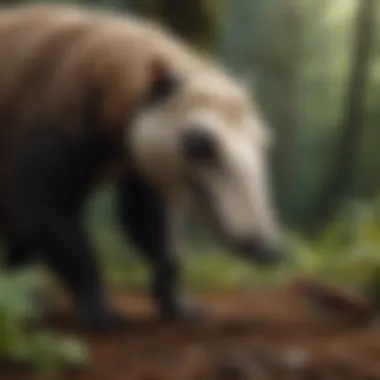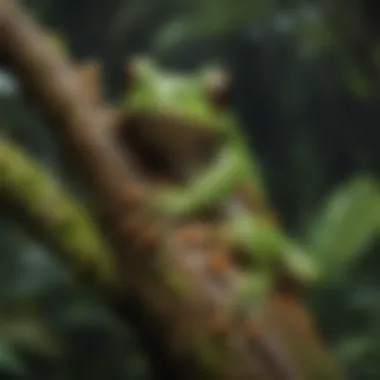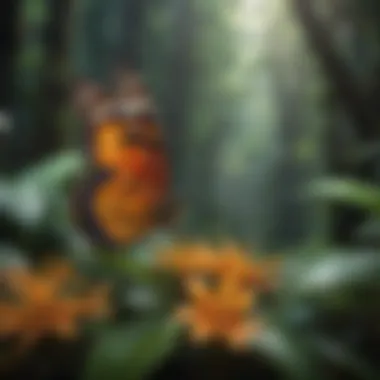Discover the Intricate World of Animals in the Rainforest Ecosystem


Nature Topic Overview
The rainforest ecosystem is a marvel of biodiversity, teeming with a vast array of animals coexisting in a delicate balance. From the majestic jaguars prowling stealthily through the lush foliage to the industrious leaf-cutter ants meticulously tending to their fungal gardens, every creature plays a crucial role in this complex tapestry of life.
Fun Facts and Trivia
Did you know that the brilliantly colored poison dart frogs found in the rainforest display vibrant hues as a warning to potential predators of their toxic nature? These tiny amphibians pack a powerful defense mechanism in their petite frames! Additionally, the agile spider monkeys swing effortlessly from tree to tree, showcasing their acrobatic prowess in the dense canopy above.
Wildlife Explorations
Venture into the depths of the rainforest to encounter the elusive sloths lazing among the branches, perfectly blending in with their surroundings. Discover the incredible diversity of bird species, from the flamboyant toucans with their oversized bills to the melodious calls of the vibrant parrots. Engage in interactive quizzes to test your knowledge of these fascinating creatures and unlock the mysteries of the rainforest ecosystem.
Environmental Awareness
Conservation efforts are vital to preserving the fragile balance of the rainforest ecosystem. Learn about the critical importance of sustainable practices and how even the smallest actions can make a positive impact on this rich habitat. Explore ways in which children can contribute to protecting nature, from reducing waste to supporting ethical wildlife tourism initiatives.
DIY Nature Activities
Immerse yourself in the wonders of nature with hands-on activities that bring the rainforest ecosystem to life in your own home. Create miniature terrariums to emulate the lush greenery of the rainforest floor or embark on a sensory nature walk to observe the sights and sounds of wildlife in your neighborhood. Encourage outdoor explorations to foster a deep appreciation for the natural world and inspire a lifelong commitment to conservation.
Introduction to Rainforest Ecosystem
In this section, we will delve into the essential foundation of the rainforest ecosystem, shedding light on its intricate dynamics and profound significance. The introduction sets the stage for our exploration of the diverse array of animals that call the rainforest their home. By elucidating the interconnectedness of various elements within this ecosystem, we aim to provide a comprehensive overview that highlights the delicate balance of life in this vibrant environment. Understanding the introduction is crucial as it lays the groundwork for our subsequent discussions on the plethora of animal species thriving in the rainforest.
Definition of Rainforest Ecosystem
The definition of a rainforest ecosystem encompasses a complex web of interactions between living organisms and their environment. A rainforest ecosystem is characterized by its dense vegetation, high levels of biodiversity, and abundant rainfall. This definition underscores the unique ecological setting that supports the rich and diverse animal life found in these lush environments. By grasping the essence of the rainforest ecosystem, we gain insight into the specific conditions that shape the lives of its inhabitants, guiding our exploration into the intricacies of animal interactions.
Characteristics of Rainforest Ecosystem
The characteristics of a rainforest ecosystem paint a vivid picture of its remarkable biodiversity and ecological complexity. From towering trees to a multilayered canopy, every aspect of the rainforest contributes to its unparalleled richness in species. The high levels of precipitation, warm climate, and nutrient-rich soil foster the ideal conditions for a myriad of plants and animals to thrive. Understanding these characteristics provides a holistic view of the rainforest ecosystem and sets the stage for a detailed examination of the animal species that play vital roles within this habitat.
Importance of Rainforests
Rainforests hold immense ecological importance as they act as vital carbon sinks, helping to regulate the Earth's climate. Additionally, these ecosystems are treasure troves of biodiversity, housing countless plant and animal species unique to their environment. Rainforests also provide essential ecosystem services such as oxygen production, water regulation, and nutrient cycling. Recognizing the critical role that rainforests play in sustaining life on our planet highlights the urgency of their conservation and underscores the significance of studying the intricate relationships within these ecosystems.


Threats to Rainforest Ecosystem
Despite their immense value, rainforest ecosystems face a host of threats that jeopardize their delicate balance and biodiversity. Deforestation, climate change, illegal wildlife trade, and habitat destruction pose significant risks to the survival of rainforest species. Understanding the threats to the rainforest ecosystem is crucial in developing conservation strategies and fostering sustainable practices that safeguard these invaluable habitats for future generations.
Diversity of Animal Species
In the sprawling rainforest ecosystem, the diversity of animal species emerges as a critical focal point. The intricate interplay between various animals forms the backbone of this rich environment, embodying a delicate balance essential for the ecosystem's health. From the majestic mammals to the colorful birds and elusive reptiles, each species contributes uniquely to the intricate web of life. This aspect not only showcases the sheer variety of life forms but also highlights the symbiotic relationships and predator-prey dynamics at play within the rainforest.
Mammals in the Rainforest
Jaguars
Jaguars, the apex predators of the rainforest, embody strength and stealth in equal measure. Their keen hunting instincts and remarkable agility make them formidable predators, crucial in controlling the population of other species. Jaguars' distinctive rosette markings camouflaged amid the dense foliage enable successful ambushes, underlining their prowess as top predators. Yet, their dwindling numbers due to habitat loss and human threats raise concerns about their long-term survival, signaling the critical role they play in this ecosystem.
Sloths
Sloths, known for their unhurried pace and arboreal lifestyle, symbolize tranquility amidst the rainforest bustle. Their slow movements and specialized adaptations for tree-dwelling reflect a harmonious coexistence with their surroundings. While their deliberate pace may seem disadvantageous, it serves as a survival strategy, conserving energy in a nutrient-scarce environment. Despite their vulnerabilities to habitat destruction, sloths remain integral to the rainforest's biodiversity, embodying resilience in the face of challenges.
Tapirs
Tapirs, the gentle giants of the rainforest, contribute to seed dispersal and vegetation growth, essential for forest regeneration. Their unique physique, resembling a blend of various animal traits, sets them apart as charismatic herbivores. Tapirs' role as ecosystem engineers underscores their significance in shaping the landscape and supporting plant diversity. However, their vulnerability to hunting pressures and habitat fragmentation underscores the need for conservation efforts to safeguard their pivotal role in maintaining the rainforest's ecological balance.
Birds of the Canopy
Toucans
Toucans, with their vibrant plumage and iconic oversized bills, epitomize the avian wonders of the rainforest canopy. Their distinctive beaks, adapted for fruit consumption and intimidation display intricate evolutionary adaptations. Toucans' role as seed dispersers aids in forest regeneration, while their raucous calls resonate through the canopy, underscoring their presence in this biodiverse landscape. Despite their charismatic appeal, habitat loss and illegal wildlife trade pose significant threats to their populations, necessitating vigilant conservation efforts to ensure their continued presence in the canopy.
Macaws
Macaws, known for their brilliant colors and raucous calls, represent the flamboyant ambassadors of the rainforest skies. Their social nature and high intelligence levels foster complex social interactions and familial bonds within their flocks. Macaws' unique nesting habits and strong beaks exemplify their adaptation to the canopy lifestyle, emphasizing their vital role in shaping the forest ecosystem. Yet, deforestation and poaching activities loom as formidable challenges, underscoring the urgency of protecting these majestic birds' habitats to preserve the canopy's biodiversity.
Hummingbirds
Hummingbirds, the delicate jewels of the rainforest, dazzle with their iridescent plumage and aerial acrobatics. Their specialized anatomy, featuring rapid wingbeats and long bills for nectar-feeding, highlight their unique ecological niche as pollinators. Hummingbirds' crucial role in pollination facilitates plant reproduction and fosters floral diversity, shaping the vibrant tapestry of the rainforest. However, climate change and habitat degradation pose threats to their delicate existence, emphasizing the need for conservation measures to safeguard these agile wonders' presence amidst the canopy.


Reptiles and Amphibians
Anacondas
Anacondas, the largest snakes in the world, evoke both fascination and fear with their massive size and aquatic prowess. Their aquatic lifestyle and constricting capabilities mark them as top predators in rainforest waterways, regulating prey populations effectively. Anacondas' secretive nature and stealthy hunting tactics underscore their adaptability to swampy environments, showcasing their evolutionary success. Nevertheless, habitat destruction and poaching activities exert pressure on anaconda populations, highlighting the urgency of preserving their wetland habitats for the rainforest's ecological integrity.
Tree Frogs
Tree frogs, with their vibrant colors and remarkable camouflage, epitomize the beauty and diversity of rainforest amphibians. Their arboreal lifestyle and adhesive toe pads enable them to navigate the dense foliage with agility, evading predators and capturing prey. Tree frogs' haunting calls reverberate through the nighttime canopy, adding to the rainforest's cacophony of sounds. Despite their ecological importance in controlling insect populations, climate change and deforestation pose grave threats to their habitat, necessitating conservation actions to safeguard these enchanting amphibians' continued presence in the rainforest.
Chameleons
Chameleons, masters of disguise and precision, showcase remarkable adaptations for survival in the rainforest's diverse habitats. Their color-changing abilities and independently mobile eyes exemplify their unique evolutionary traits for communication and camouflage. Chameleons' specialized tongue-projection mechanism aids in capturing prey with unmatched accuracy, highlighting their prowess as insectivores. However, habitat fragmentation and illegal pet trade activities endanger chameleon populations, underscoring the need for habitat protection measures to ensure these intriguing reptiles thrive in their rainforest home.
Insects and Arachnids
Butterflies
Butterflies, with their delicate wings and vibrant patterns, symbolize the ephemeral beauty and ecological significance of rainforest insects. Their pollination services facilitate plant reproduction and foster floral diversity, essential for forest regeneration. Butterflies' intricate life cycles, from caterpillars to adults, reflect their vital roles as indicators of ecosystem health and biodiversity. Yet, pesticide use and habitat loss threaten butterfly populations, emphasizing the imperative of conserving their habitats to sustain the rainforest's pollination networks.
Tarantulas
Tarantulas, the enigmatic predators of the rainforest floor, evoke intrigue and reverence with their large size and venomous capabilities. Their nocturnal habits and burrowing behaviors contribute to regulating insect populations, maintaining ecological balance. Tarantulas' silk-spinning abilities and tactile hairs serve as defense mechanisms and aid in prey capture, showcasing their specialized adaptations. Despite their crucial role in the ecosystem, habitat destruction and misconceptions fueling their persecution pose threats to tarantula populations, stressing the need for habitat protection to ensure their survival in the intricate rainforest ecosystem.
Leafcutter Ants
Leafcutter ants, the industrious architects of the rainforest floor, exemplify complex social structures and cooperative foraging behaviors. Their leaf-cutting activities and fungal agriculture practices contribute to soil aeration and nutrient cycling, influencing forest health. Leafcutter ants' division of labor and adaptive behaviors ensure colony success amidst challenges, underscoring their resilience in the ever-changing rainforest environment. Despite their ecological significance, deforestation and agricultural encroachment disrupt leafcutter ant colonies, highlighting the importance of preserving their habitats to sustain the rainforest's intricate ecological relationships.
Predator-Prey Relationships
Predator-prey relationships play a crucial role in the intricate web of life within the rainforest ecosystem. The dynamic interplay between predators and their prey is essential for maintaining the delicate balance of the ecosystem. Jaguars, sloths, and tapirs are key players in this complex relationship, each contributing to the ecosystem's biodiversity. Predators help in controlling the population of prey species, preventing overgrazing or depletion of resources. They also aid in eliminating sick or weak individuals, maintaining the overall health of the prey population.
Hunting Strategies in the Rainforest
Within the dense vegetation of the rainforest, predators have developed an array of hunting strategies to capture their prey efficiently. Jaguars, the apex predators of the rainforest, employ stealth and ambush tactics to surprise their victims. Sloths, known for their slow movements, rely on camouflaging techniques to evade detection by predators. Tapirs utilize their keen sense of smell and excellent swimming abilities to outmaneuver potential threats. These diverse hunting strategies reflect the unique adaptations of each predator to its environment, showcasing the intricate survival mechanisms at play in the rainforest.


Adaptations for Survival
Survival in the rainforest hinges on an organism's ability to adapt to its surroundings. Predators have evolved various physical and behavioral adaptations to enhance their chances of survival. Sharp claws and teeth enable jaguars to effectively subdue their prey, while sloths' slow metabolism helps conserve energy in the resource-scarce environment. Tapirs' ability to feed on a wide range of plant species allows them to adapt to fluctuations in food availability. These adaptations highlight the resilience of rainforest species and underscore the constant evolutionary arms race between predators and their prey.
Symbiotic Interactions
The study of symbiotic interactions in the rainforest ecosystem uncovers the intricate relationships between different species that coexist in a delicate balance. This crucial aspect of the ecosystem plays a vital role in maintaining biodiversity and ecosystem stability. Symbiotic interactions involve various forms of relationships, including mutualism, commensalism, and parasitism. Each type of interaction brings its own set of benefits and challenges, contributing to the complex web of life in the rainforest. Understanding these symbiotic relationships is essential for comprehending the dynamics of the ecosystem and the interdependence of its inhabitants.
Mutualism in the Rainforest
Mutualism, a form of symbiosis, is a prevalent phenomenon in the rainforest ecosystem where two different species benefit from their association. This mutually beneficial relationship is seen in various instances, such as pollination by insects and birds, where both species gain advantages. In the rainforest, mutualistic interactions are crucial for the survival and reproduction of many plant and animal species. For instance, certain plants provide nectar to pollinators in exchange for assisting in their reproduction. This reciprocal exchange of benefits reinforces the interconnectedness of species and highlights the importance of cooperation in sustaining the delicate balance of the ecosystem.
Commensalism Among Species
Commensalism in the rainforest involves a relationship where one species benefits, while the other remains unaffected. This type of interaction is common among species that share habitats but do not directly interact. For instance, certain bird species build nests in trees without causing harm to the host tree. While the birds benefit from shelter, the tree is neither harmed nor benefited from this association. Commensal relationships contribute to the complexity of the ecosystem by allowing species to coexist harmoniously without significant impact on each other. Understanding the nuances of commensal interactions enriches our understanding of the diverse strategies organisms employ to thrive in the rainforest environment.
Parasitism and Its Impact
Parasitism, a form of symbiotic relationship where one species (parasite) benefits at the expense of another species (host), also plays a significant role in the rainforest ecosystem. Parasites rely on their hosts for resources, often causing harm or inconvenience to the host organism. While parasitism can have detrimental effects on individual organisms, it also contributes to ecosystem dynamics by regulating population sizes and promoting species diversity. Studying parasitism in the rainforest provides insights into the intricate balance between parasites and hosts and the evolutionary adaptations that have emerged as a result of this coevolutionary relationship.
Conservation Efforts in the Rainforest
In the realm of rainforests, Conservation Efforts stand as a beacon of hope amidst the challenges faced by these vital ecosystems. This section delves into the critical significance of preserving rainforests and the diverse animal species they harbor. Conservation Efforts serve as a shield against the encroaching threats that jeopardize the delicate balance of these rich habitats. By focusing on preserving the rainforest's biodiversity, Conservation Efforts aim to safeguard not just the animals that call it home, but also the intricate interconnections that bind the ecosystem together. Conservation Efforts honor the irreplaceable value of these habitats, recognizing them as invaluable reservoirs of life on Earth.
Challenges in Rainforest Conservation
Amidst the noble undertaking of Rainforest Conservation, numerous challenges loom large, presenting formidable obstacles to the preservation of these precious ecosystems. The unrelenting forces of deforestation, habitat fragmentation, and climate change cast a dark shadow over Rainforest Conservation efforts. The loss of pristine rainforest areas due to human activities poses a grave threat to the survival of countless animal species, pushing many to the brink of extinction. As these challenges escalate, the urgency to address them grows, demanding innovative solutions and unwavering commitment from all stakeholders involved in Rainforest Conservation.
Initiatives for Protecting Wildlife
Initiatives for Protecting Wildlife serve as beacons of hope in the battle to safeguard the fragile tapestry of life in the rainforest ecosystem. These initiatives encompass a wide array of strategies aimed at mitigating the threats faced by vulnerable animal species. From establishing protected areas and wildlife reserves to implementing community-based conservation projects, Initiatives for Protecting Wildlife take a proactive stance in combating the perils plaguing rainforest fauna. By promoting education, advocacy, and sustainable practices, these initiatives aim to empower local communities and engender a sense of shared responsibility towards the preservation of wildlife in the rainforest.
Exploring the Mysteries of the Rainforest
In the vast expanse of the rainforest, lies a realm of enigmatic wonders waiting to be uncovered. The exploration of these mysteries is not merely a scientific endeavor but a journey into the heart of ancient secrets and ecological complexities. Understanding the hidden facets of the rainforest unveils a deeper comprehension of the delicate balance that sustains life within its verdant borders. Through delving into these enigmas, we unearth profound insights that illuminate the intricate connections between species and the profound mysteries that continue to intrigue and astonish researchers and explorers alike.
Unsolved Puzzles of Rainforest Fauna
The rainforest harbors a myriad of enigmas, puzzles that have puzzled scientists and naturalists for generations. From the cryptic behaviors of elusive species to the mysterious adaptations that defy conventional understanding, the unsolved puzzles of rainforest fauna present a tapestry of intrigue and bewilderment. These mysteries challenge our perception of the natural world, pushing us to seek answers beyond the obvious and mundane. By delving into these enigmatic phenomena, we are propelled into a realm of discovery where each puzzle unraveled unveils a new layer of complexity and fascination.
Research Advances in Rainforest Biodiversity
Amidst the dense foliage and cacophony of life in the rainforest, researchers tirelessly work to illuminate the intricate web of biodiversity that thrives in this green sanctuary. Through groundbreaking studies and painstaking observations, scientists have made significant strides in unraveling the complexities of rainforest biodiversity. These research advances not only enhance our understanding of the interconnectivity between species but also shed light on the pressing issues of conservation and ecological sustainability. By harnessing the latest technological tools and scientific methodologies, researchers continue to unveil the hidden treasures of rainforest biodiversity, offering a glimmer of hope amidst the encroaching threats to these majestic ecosystems.







